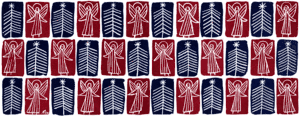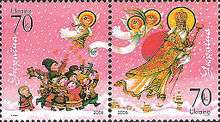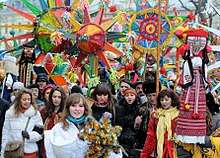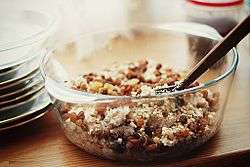Christmas in Ukraine

Beginning 2017, Ukrainian Christmas festivities start on Christmas Eve, which is celebrated on 24 December following the Gregorian calendar in official use in the Western Christian communities of Ukraine. The Christmas celebrations end on 19 January, the date of "Jordan" or Epiphany in the Julian calendar.[1]
Both the December 25 Western Christianity Christmas Day and the January 7 Christmas Day of the Eastern Orthodox Church and Ukrainian Greek Catholic Churches following the Julian Calendar, are public holidays in Ukraine.[2][3] With these two holiday dates the Ukrainian Christmas period lasts for an extended period, with the celebrations starting on December 6, the Western Christian observance of the Feast of Saint Nicholas and ending on the aforementioned January 19 the following year.
Sviatyi Vechir (Holy Evening)
Christmas Eve, or as it called 'Sviatyi Vechir' in Ukrainian ('Holy Evening') is filled with numerous customs and rituals. The customs include: decorating house and dinner table with special attributes (didukh, garlic, hay and others), performing koliadky ('carols') and so on. Each ritual has its own meaning and purpose, as such a few wisps of hay on the embroidered table cloth as a reminder of the manger in Bethlehem. One the most prominent customs of the night is a special supper, called Sviata Vecherya (Holy Supper).
Kutia (sweet grain pudding) is traditionally served at the Ukrainian Christmas dinner table. It is often the first dish in the traditional twelve-dish Christmas Eve supper (also known as Svyaty Vechir) and is rarely served at other times of the year.[4]
Koliadky (Caroling)
At the end of the Sviata Vechera the family often sings Ukrainian Christmas carols. In many communities the ancient Ukrainian tradition of caroling is carried on by groups of young people and members of organizations and churches calling at homes and collecting donations. The Ukrainian song "Shchedryk" became the basis for the world-famous Christmas carol, "Carol of the Bells". Another well-known carol is Boh predvičnyj narodivsja.[5]
Didukh (Grandfather)
When the children see the first star in the eastern evening sky, symbolizing the trek of the Three Wise Men, the Sviata Vecherya may begin. In farming communities the head of the household now brings in a sheaf of wheat called the didukh which represents the importance of the ancient and rich wheat crops of Ukraine, the staff of life through the centuries. Didukh means literally "grandfather spirit" so it symbolizes the family's ancestors. In city homes a few stalks of golden wheat in a vase are often used to decorate the table.
Shopka (Nativity scene)
Shopka is a traditional portable nativity scene used to represent nativity and other figures in a puppet form.
Christmas Tree
Small ornaments in the shape of a spider (known as pavuchky, literally "little spiders") and spider webs are traditionally a part of Ukrainian Christmas tree decorations. They represent the Legend of the Christmas Spider.
Gallery




Further reading
Kutia, Star of the Ukrainian Christmas Eve Supper
Kylymnyk, Stepan, 1955–1969; Ukrainskyi Rik u Narodnykh Zvychayakh v Narodnomu Osvitlenni [Ukrainian Year in Folk Customs from Historical Perspective], Winnipeg, Toronto
Tracz, Orysia 2015, First Star I See Tonight, Mazepa Publications Zhuravli, Winnipeg
Ukrainian Christmas Traditions, Ukrainian International Directory
Voropai, Oleksa 1958, Zvychai Nashoho Narodu [Customs of Our People], Ukrainske Vydavnytstvo, Munich
Yakovenko, Svitlana 2016, Ukrainian Christmas Eve Supper: Traditional village recipes for Sviata Vecheria, Sova Books, Sydney
See also
References
| Wikimedia Commons has media related to Christmas in Ukraine. |
- ↑ Christmas Traditions
- ↑ "Ukraine seeks distance from Moscow with new Christmas holiday". m.digitaljournal.com. Retrieved 2017-11-16.
- ↑ (in Ukrainian) "Рада зробила 25 грудня вихідним днем". BBC Україна. 2017-11-16. Retrieved 2017-11-16.
- ↑ Sviat Vechir
- ↑ "Boh predvičnyj". Metropolitan Cantor Institute. Byzantine Catholic. Retrieved 12 August 2015.



